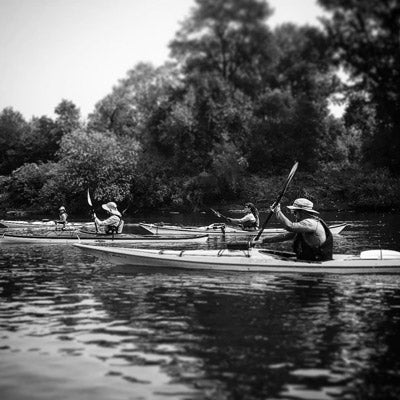
What’s In a Blade? Choosing the Right Kayak Paddle
So you’ve just purchased your new kayak, that’s great! Unfortunately, you’ve got just a bit more work to do to ensure that your paddling experiences create the most value for you. Fortunately, this will pay off in the long run. A large portion of that work comes down to choosing the right paddle for your own paddling technique. There are SO many different options when it comes to choosing a paddle that it can seem like a daunting task that you’d rather just dismiss and buy a cheap “do it all paddle” and be done with it. Let me tell you, you’ll be glad you don’t go this route and if you’re able to choose the right paddle from the beginning you’ll be that much happier.
When it comes to picking the perfect paddle for you there are many variables to consider. What materials are used to construct the paddle? How long of a paddle do you need? Does it matter? Why are the blades shaped differently? Bent shaft versus straight shaft? What is a shaft?! Fret not; I’m here to lay it all out for you. I’ll tackle each one of these topics as succinctly and objectively as possible for such a subjective matter.
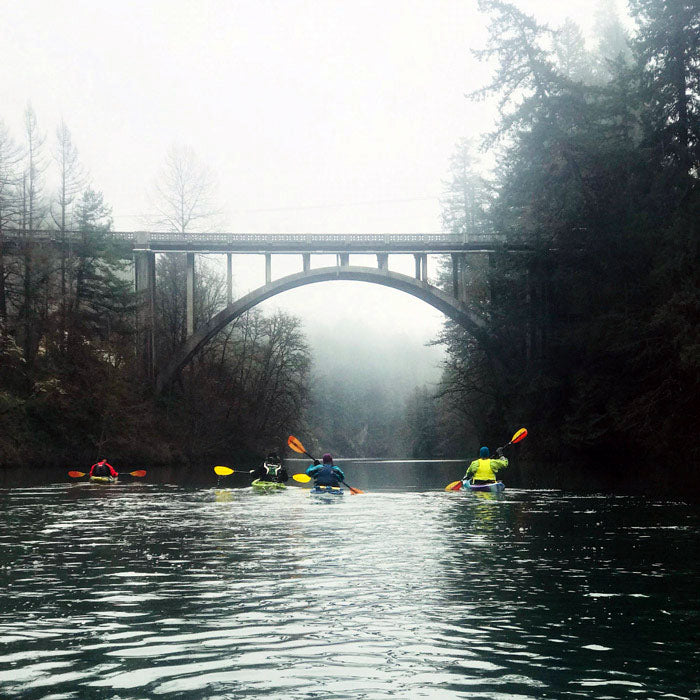 Why does it matter?
To start out this discussion I want to lay out the importance of why choosing the right paddle matters. As the saying goes, you date your kayak and you marry your paddle. This saying can, of course, be argued, but there is a lot of truth in its roots. Here’s why I wouldn’t recommend cutting corners when it comes to purchasing your paddle. To put it as simply as possible, the paddle is in your hands the entire time you’re paddling, so if you purchase the wrong paddle you’ll feel a degree of annoyance while on the water and this may paint your paddling picture with the wrong color. Pick the right paddle, and with each stroke, you’ll paint a paddling masterpiece. Now, let’s get into the nitty-gritty.
Why does it matter?
To start out this discussion I want to lay out the importance of why choosing the right paddle matters. As the saying goes, you date your kayak and you marry your paddle. This saying can, of course, be argued, but there is a lot of truth in its roots. Here’s why I wouldn’t recommend cutting corners when it comes to purchasing your paddle. To put it as simply as possible, the paddle is in your hands the entire time you’re paddling, so if you purchase the wrong paddle you’ll feel a degree of annoyance while on the water and this may paint your paddling picture with the wrong color. Pick the right paddle, and with each stroke, you’ll paint a paddling masterpiece. Now, let’s get into the nitty-gritty.
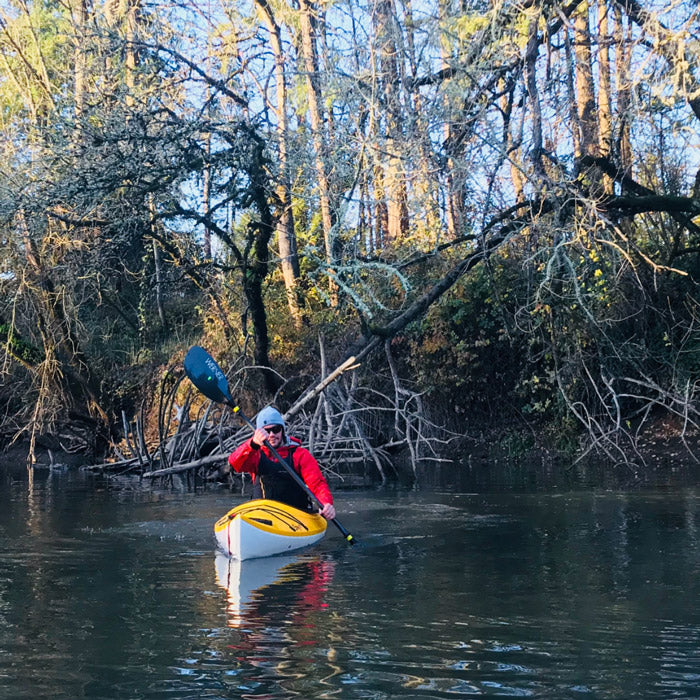 Price point.
Let’s start with the price point. Why is this paddle $400 and this one is $35? Good question. Here it is, a cheaper paddle will be heavy and weak whereas a more expensive paddle will be light and strong. That is, a cheap paddle will feel heavy in your hands and will flex with each stroke, meaning energy lost due to holding the paddle as well as energy lost as you move the paddle through the water from the flex of the blade. A paddle with a higher price point will feel like you’re holding onto nothing and swinging nothing more than air. On top of that, there is no flex in the blade or shaft as you move the paddle through the water, no energy wasted. This is a very important factor when choosing a paddle. If you plan on paddling with a purpose or plan on getting on the water often it is worth the extra money to purchase a paddle that isn’t going to be a waste of your energy. It’s a night and day difference.
Price point.
Let’s start with the price point. Why is this paddle $400 and this one is $35? Good question. Here it is, a cheaper paddle will be heavy and weak whereas a more expensive paddle will be light and strong. That is, a cheap paddle will feel heavy in your hands and will flex with each stroke, meaning energy lost due to holding the paddle as well as energy lost as you move the paddle through the water from the flex of the blade. A paddle with a higher price point will feel like you’re holding onto nothing and swinging nothing more than air. On top of that, there is no flex in the blade or shaft as you move the paddle through the water, no energy wasted. This is a very important factor when choosing a paddle. If you plan on paddling with a purpose or plan on getting on the water often it is worth the extra money to purchase a paddle that isn’t going to be a waste of your energy. It’s a night and day difference.
 Quality and construction.
So now, what makes one paddle more expensive than another? The answer is simply the material that it is made from. Just for fun, let’s start from the top. The best paddles are made entirely of carbon fiber. That means both the shaft and the blade are nothing but carbon fiber. This is the stiffest and lightest material out there being used to construct paddles. I’ve paddled everything from the cheapest to the most expensive paddles and I can tell you firsthand, there is nothing quite like paddling a carbon fiber paddle. SO light, so stiff, if you’re out of energy at the end of your adventure it’s definitely not because of the paddle. There is zero flex, they weigh nothing, and they just look downright sexy.
Taking a step down from there we are still in the realm of a quality paddle. For those of you looking for a good paddle that is not the top shelf, you’ll want to find a paddle that uses a carbon composite for the shaft and fiberglass for the blade. These are just a tad bit heavier but still extremely light. Given that they are using carbon in their shaft and fiberglass in the blade they will not flex on you through the water. No energy wasted during your stroke, just slightly more effort involved in holding the paddle. This is the category that I recommend to folks just entering the paddling sports arena. The price point is mid to high range but the quality of the paddle is not sacrificed. A paddle in this category could serve your purposes for a lifetime. If you find you are really paddling often then maybe upgrading to a carbon fiber paddle is your answer.
There are two steps to take down from here. The first is a plastic blade that is injected with carbon and a carbon composite shaft. These paddles will be noticeably heavier yet still utilize carbon. A plastic blade that is injected with carbon will still be stronger than a blade made entirely of plastic but it will introduce a degree of flex, which translates to energy lost with each stroke. Most of these paddles are constructed with a carbon composite shaft, which is a good thing.
The next step down is the introductory paddle, the price point paddle. These paddles are made from an aluminum shaft and a plastic blade. They are heavy and produce a lot of flex with every stroke. Their efficiency is very low and their weight is very high. Short story, you will tire very fast using a paddle like this. On top of that, aluminum is subject to outside temperatures, meaning it will be very cold to grip in the winter and very hot in the summer. Of course, this does not encompass every single option but it lays the groundwork for you to work from.
Paddle length.
Now, to tackle the length of your paddle. We can make this short. To put it objectively, your paddle length comes down to the ratio between your height and your kayaks width. The reasoning for this is to eliminate the chance of you bumping the shaft on the side of your kayak and to ensure that the blade enters the water precisely when you want it to. When purchasing your paddle come equipped with this information and it will be easy to follow the chart that is on each paddles tag to determine your correct size. To put it subjectively, the answer is entirely up to you. For example, when paddling the Eddyline Rio I am recommended to use a 220cm paddle, yet I have a much more satisfying experience when I use a much shorter paddle, along the lines of a 205cm. This comes down to your own paddling technique.
Quality and construction.
So now, what makes one paddle more expensive than another? The answer is simply the material that it is made from. Just for fun, let’s start from the top. The best paddles are made entirely of carbon fiber. That means both the shaft and the blade are nothing but carbon fiber. This is the stiffest and lightest material out there being used to construct paddles. I’ve paddled everything from the cheapest to the most expensive paddles and I can tell you firsthand, there is nothing quite like paddling a carbon fiber paddle. SO light, so stiff, if you’re out of energy at the end of your adventure it’s definitely not because of the paddle. There is zero flex, they weigh nothing, and they just look downright sexy.
Taking a step down from there we are still in the realm of a quality paddle. For those of you looking for a good paddle that is not the top shelf, you’ll want to find a paddle that uses a carbon composite for the shaft and fiberglass for the blade. These are just a tad bit heavier but still extremely light. Given that they are using carbon in their shaft and fiberglass in the blade they will not flex on you through the water. No energy wasted during your stroke, just slightly more effort involved in holding the paddle. This is the category that I recommend to folks just entering the paddling sports arena. The price point is mid to high range but the quality of the paddle is not sacrificed. A paddle in this category could serve your purposes for a lifetime. If you find you are really paddling often then maybe upgrading to a carbon fiber paddle is your answer.
There are two steps to take down from here. The first is a plastic blade that is injected with carbon and a carbon composite shaft. These paddles will be noticeably heavier yet still utilize carbon. A plastic blade that is injected with carbon will still be stronger than a blade made entirely of plastic but it will introduce a degree of flex, which translates to energy lost with each stroke. Most of these paddles are constructed with a carbon composite shaft, which is a good thing.
The next step down is the introductory paddle, the price point paddle. These paddles are made from an aluminum shaft and a plastic blade. They are heavy and produce a lot of flex with every stroke. Their efficiency is very low and their weight is very high. Short story, you will tire very fast using a paddle like this. On top of that, aluminum is subject to outside temperatures, meaning it will be very cold to grip in the winter and very hot in the summer. Of course, this does not encompass every single option but it lays the groundwork for you to work from.
Paddle length.
Now, to tackle the length of your paddle. We can make this short. To put it objectively, your paddle length comes down to the ratio between your height and your kayaks width. The reasoning for this is to eliminate the chance of you bumping the shaft on the side of your kayak and to ensure that the blade enters the water precisely when you want it to. When purchasing your paddle come equipped with this information and it will be easy to follow the chart that is on each paddles tag to determine your correct size. To put it subjectively, the answer is entirely up to you. For example, when paddling the Eddyline Rio I am recommended to use a 220cm paddle, yet I have a much more satisfying experience when I use a much shorter paddle, along the lines of a 205cm. This comes down to your own paddling technique.
 Blade shape.
On the note of paddling technique, let’s talk blade shape. While shopping you may notice two distinct blade shapes. One of them is long and narrow, the other short and wide. These are low angle and high angle paddles. What this is referring to is the angle at which the blade will enter the water. In an effort to simplify, the low angle is the marathon runner and the high angle is the sprinter. If your left blade enters the water while your right blade is at about ear height you might be a low angle paddler. On the other end of that if your left blade enters the water while your right blade is above your head you might want to choose a high angle blade. Objectively, a low angle blade pushes less water with each stroke and builds its efficiency through a repetitive cadence whereas a high angle blade pushes more water with each stroke and is used most efficiently on a stroke to stroke basis. So if you want to paddle in a straight line from point X to point Y a low angle blade may be your answer. If you want to maneuver quickly and sprint from one spot to another a high angle blade me be your best bet. Again, this is all subjective. I recommend trying several blades, trading with your buddies while you’re paddling, etc. to find out exactly what kind of paddling you do.
Blade shape.
On the note of paddling technique, let’s talk blade shape. While shopping you may notice two distinct blade shapes. One of them is long and narrow, the other short and wide. These are low angle and high angle paddles. What this is referring to is the angle at which the blade will enter the water. In an effort to simplify, the low angle is the marathon runner and the high angle is the sprinter. If your left blade enters the water while your right blade is at about ear height you might be a low angle paddler. On the other end of that if your left blade enters the water while your right blade is above your head you might want to choose a high angle blade. Objectively, a low angle blade pushes less water with each stroke and builds its efficiency through a repetitive cadence whereas a high angle blade pushes more water with each stroke and is used most efficiently on a stroke to stroke basis. So if you want to paddle in a straight line from point X to point Y a low angle blade may be your answer. If you want to maneuver quickly and sprint from one spot to another a high angle blade me be your best bet. Again, this is all subjective. I recommend trying several blades, trading with your buddies while you’re paddling, etc. to find out exactly what kind of paddling you do.
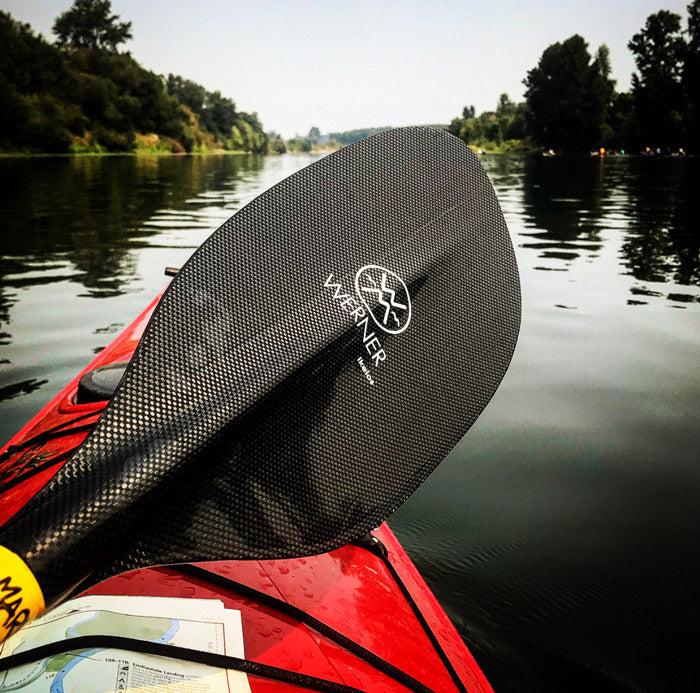 Straight vs. bent shaft.
Now for the last bit, straight shaft versus bent shaft. Most paddlers use a straight shaft. And just in case it isn’t clear, the shaft is the material connecting the two blades, it’s what you hold on to. Here’s the deal, it’s completely up to the paddler. Some swear on a bent shaft while others can’t stand them. Personally, I feel at home using both. A bent shaft is designed to eliminate stress on the tendons throughout the wrist, forearm, and shoulder. If you have any stress in those areas it will be in your benefit to use a bent shaft paddle. It is more anatomically ergonomic to grasp a bent shaft. Again, try both if you can and choose for yourself.
Straight vs. bent shaft.
Now for the last bit, straight shaft versus bent shaft. Most paddlers use a straight shaft. And just in case it isn’t clear, the shaft is the material connecting the two blades, it’s what you hold on to. Here’s the deal, it’s completely up to the paddler. Some swear on a bent shaft while others can’t stand them. Personally, I feel at home using both. A bent shaft is designed to eliminate stress on the tendons throughout the wrist, forearm, and shoulder. If you have any stress in those areas it will be in your benefit to use a bent shaft paddle. It is more anatomically ergonomic to grasp a bent shaft. Again, try both if you can and choose for yourself.
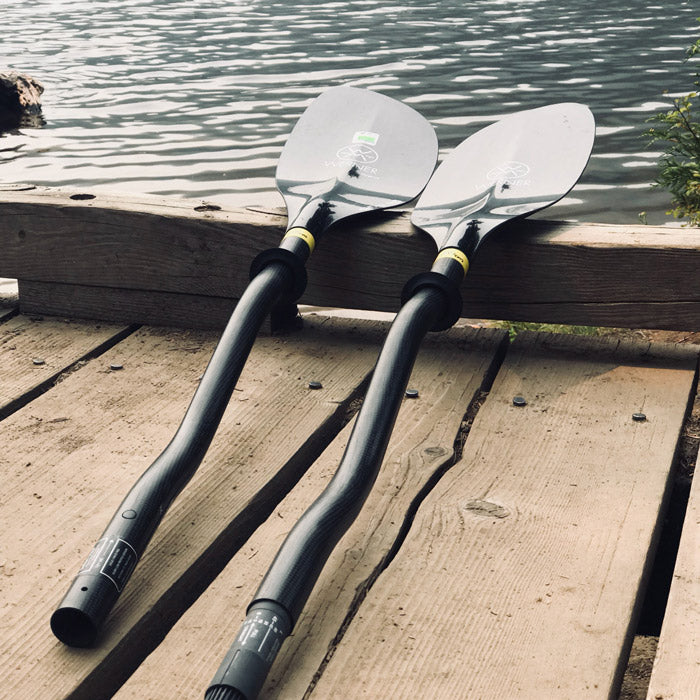 I hope this helps while you are shopping around for your next or first paddle. The ultimate answer is there is no right answer. There are a few objective truths but really it comes down to what do you feel most comfortable using. Just because your friend loves Paddle X doesn’t mean it will necessarily be the right paddle for you. Educate yourself, learn your own technique, demo if available and you will find your time on the water to be as enjoyable as possible.
I hope this helps while you are shopping around for your next or first paddle. The ultimate answer is there is no right answer. There are a few objective truths but really it comes down to what do you feel most comfortable using. Just because your friend loves Paddle X doesn’t mean it will necessarily be the right paddle for you. Educate yourself, learn your own technique, demo if available and you will find your time on the water to be as enjoyable as possible.
 Why does it matter?
To start out this discussion I want to lay out the importance of why choosing the right paddle matters. As the saying goes, you date your kayak and you marry your paddle. This saying can, of course, be argued, but there is a lot of truth in its roots. Here’s why I wouldn’t recommend cutting corners when it comes to purchasing your paddle. To put it as simply as possible, the paddle is in your hands the entire time you’re paddling, so if you purchase the wrong paddle you’ll feel a degree of annoyance while on the water and this may paint your paddling picture with the wrong color. Pick the right paddle, and with each stroke, you’ll paint a paddling masterpiece. Now, let’s get into the nitty-gritty.
Why does it matter?
To start out this discussion I want to lay out the importance of why choosing the right paddle matters. As the saying goes, you date your kayak and you marry your paddle. This saying can, of course, be argued, but there is a lot of truth in its roots. Here’s why I wouldn’t recommend cutting corners when it comes to purchasing your paddle. To put it as simply as possible, the paddle is in your hands the entire time you’re paddling, so if you purchase the wrong paddle you’ll feel a degree of annoyance while on the water and this may paint your paddling picture with the wrong color. Pick the right paddle, and with each stroke, you’ll paint a paddling masterpiece. Now, let’s get into the nitty-gritty.
 Price point.
Let’s start with the price point. Why is this paddle $400 and this one is $35? Good question. Here it is, a cheaper paddle will be heavy and weak whereas a more expensive paddle will be light and strong. That is, a cheap paddle will feel heavy in your hands and will flex with each stroke, meaning energy lost due to holding the paddle as well as energy lost as you move the paddle through the water from the flex of the blade. A paddle with a higher price point will feel like you’re holding onto nothing and swinging nothing more than air. On top of that, there is no flex in the blade or shaft as you move the paddle through the water, no energy wasted. This is a very important factor when choosing a paddle. If you plan on paddling with a purpose or plan on getting on the water often it is worth the extra money to purchase a paddle that isn’t going to be a waste of your energy. It’s a night and day difference.
Price point.
Let’s start with the price point. Why is this paddle $400 and this one is $35? Good question. Here it is, a cheaper paddle will be heavy and weak whereas a more expensive paddle will be light and strong. That is, a cheap paddle will feel heavy in your hands and will flex with each stroke, meaning energy lost due to holding the paddle as well as energy lost as you move the paddle through the water from the flex of the blade. A paddle with a higher price point will feel like you’re holding onto nothing and swinging nothing more than air. On top of that, there is no flex in the blade or shaft as you move the paddle through the water, no energy wasted. This is a very important factor when choosing a paddle. If you plan on paddling with a purpose or plan on getting on the water often it is worth the extra money to purchase a paddle that isn’t going to be a waste of your energy. It’s a night and day difference.
 Quality and construction.
So now, what makes one paddle more expensive than another? The answer is simply the material that it is made from. Just for fun, let’s start from the top. The best paddles are made entirely of carbon fiber. That means both the shaft and the blade are nothing but carbon fiber. This is the stiffest and lightest material out there being used to construct paddles. I’ve paddled everything from the cheapest to the most expensive paddles and I can tell you firsthand, there is nothing quite like paddling a carbon fiber paddle. SO light, so stiff, if you’re out of energy at the end of your adventure it’s definitely not because of the paddle. There is zero flex, they weigh nothing, and they just look downright sexy.
Taking a step down from there we are still in the realm of a quality paddle. For those of you looking for a good paddle that is not the top shelf, you’ll want to find a paddle that uses a carbon composite for the shaft and fiberglass for the blade. These are just a tad bit heavier but still extremely light. Given that they are using carbon in their shaft and fiberglass in the blade they will not flex on you through the water. No energy wasted during your stroke, just slightly more effort involved in holding the paddle. This is the category that I recommend to folks just entering the paddling sports arena. The price point is mid to high range but the quality of the paddle is not sacrificed. A paddle in this category could serve your purposes for a lifetime. If you find you are really paddling often then maybe upgrading to a carbon fiber paddle is your answer.
There are two steps to take down from here. The first is a plastic blade that is injected with carbon and a carbon composite shaft. These paddles will be noticeably heavier yet still utilize carbon. A plastic blade that is injected with carbon will still be stronger than a blade made entirely of plastic but it will introduce a degree of flex, which translates to energy lost with each stroke. Most of these paddles are constructed with a carbon composite shaft, which is a good thing.
The next step down is the introductory paddle, the price point paddle. These paddles are made from an aluminum shaft and a plastic blade. They are heavy and produce a lot of flex with every stroke. Their efficiency is very low and their weight is very high. Short story, you will tire very fast using a paddle like this. On top of that, aluminum is subject to outside temperatures, meaning it will be very cold to grip in the winter and very hot in the summer. Of course, this does not encompass every single option but it lays the groundwork for you to work from.
Paddle length.
Now, to tackle the length of your paddle. We can make this short. To put it objectively, your paddle length comes down to the ratio between your height and your kayaks width. The reasoning for this is to eliminate the chance of you bumping the shaft on the side of your kayak and to ensure that the blade enters the water precisely when you want it to. When purchasing your paddle come equipped with this information and it will be easy to follow the chart that is on each paddles tag to determine your correct size. To put it subjectively, the answer is entirely up to you. For example, when paddling the Eddyline Rio I am recommended to use a 220cm paddle, yet I have a much more satisfying experience when I use a much shorter paddle, along the lines of a 205cm. This comes down to your own paddling technique.
Quality and construction.
So now, what makes one paddle more expensive than another? The answer is simply the material that it is made from. Just for fun, let’s start from the top. The best paddles are made entirely of carbon fiber. That means both the shaft and the blade are nothing but carbon fiber. This is the stiffest and lightest material out there being used to construct paddles. I’ve paddled everything from the cheapest to the most expensive paddles and I can tell you firsthand, there is nothing quite like paddling a carbon fiber paddle. SO light, so stiff, if you’re out of energy at the end of your adventure it’s definitely not because of the paddle. There is zero flex, they weigh nothing, and they just look downright sexy.
Taking a step down from there we are still in the realm of a quality paddle. For those of you looking for a good paddle that is not the top shelf, you’ll want to find a paddle that uses a carbon composite for the shaft and fiberglass for the blade. These are just a tad bit heavier but still extremely light. Given that they are using carbon in their shaft and fiberglass in the blade they will not flex on you through the water. No energy wasted during your stroke, just slightly more effort involved in holding the paddle. This is the category that I recommend to folks just entering the paddling sports arena. The price point is mid to high range but the quality of the paddle is not sacrificed. A paddle in this category could serve your purposes for a lifetime. If you find you are really paddling often then maybe upgrading to a carbon fiber paddle is your answer.
There are two steps to take down from here. The first is a plastic blade that is injected with carbon and a carbon composite shaft. These paddles will be noticeably heavier yet still utilize carbon. A plastic blade that is injected with carbon will still be stronger than a blade made entirely of plastic but it will introduce a degree of flex, which translates to energy lost with each stroke. Most of these paddles are constructed with a carbon composite shaft, which is a good thing.
The next step down is the introductory paddle, the price point paddle. These paddles are made from an aluminum shaft and a plastic blade. They are heavy and produce a lot of flex with every stroke. Their efficiency is very low and their weight is very high. Short story, you will tire very fast using a paddle like this. On top of that, aluminum is subject to outside temperatures, meaning it will be very cold to grip in the winter and very hot in the summer. Of course, this does not encompass every single option but it lays the groundwork for you to work from.
Paddle length.
Now, to tackle the length of your paddle. We can make this short. To put it objectively, your paddle length comes down to the ratio between your height and your kayaks width. The reasoning for this is to eliminate the chance of you bumping the shaft on the side of your kayak and to ensure that the blade enters the water precisely when you want it to. When purchasing your paddle come equipped with this information and it will be easy to follow the chart that is on each paddles tag to determine your correct size. To put it subjectively, the answer is entirely up to you. For example, when paddling the Eddyline Rio I am recommended to use a 220cm paddle, yet I have a much more satisfying experience when I use a much shorter paddle, along the lines of a 205cm. This comes down to your own paddling technique.
 Blade shape.
On the note of paddling technique, let’s talk blade shape. While shopping you may notice two distinct blade shapes. One of them is long and narrow, the other short and wide. These are low angle and high angle paddles. What this is referring to is the angle at which the blade will enter the water. In an effort to simplify, the low angle is the marathon runner and the high angle is the sprinter. If your left blade enters the water while your right blade is at about ear height you might be a low angle paddler. On the other end of that if your left blade enters the water while your right blade is above your head you might want to choose a high angle blade. Objectively, a low angle blade pushes less water with each stroke and builds its efficiency through a repetitive cadence whereas a high angle blade pushes more water with each stroke and is used most efficiently on a stroke to stroke basis. So if you want to paddle in a straight line from point X to point Y a low angle blade may be your answer. If you want to maneuver quickly and sprint from one spot to another a high angle blade me be your best bet. Again, this is all subjective. I recommend trying several blades, trading with your buddies while you’re paddling, etc. to find out exactly what kind of paddling you do.
Blade shape.
On the note of paddling technique, let’s talk blade shape. While shopping you may notice two distinct blade shapes. One of them is long and narrow, the other short and wide. These are low angle and high angle paddles. What this is referring to is the angle at which the blade will enter the water. In an effort to simplify, the low angle is the marathon runner and the high angle is the sprinter. If your left blade enters the water while your right blade is at about ear height you might be a low angle paddler. On the other end of that if your left blade enters the water while your right blade is above your head you might want to choose a high angle blade. Objectively, a low angle blade pushes less water with each stroke and builds its efficiency through a repetitive cadence whereas a high angle blade pushes more water with each stroke and is used most efficiently on a stroke to stroke basis. So if you want to paddle in a straight line from point X to point Y a low angle blade may be your answer. If you want to maneuver quickly and sprint from one spot to another a high angle blade me be your best bet. Again, this is all subjective. I recommend trying several blades, trading with your buddies while you’re paddling, etc. to find out exactly what kind of paddling you do.
 Straight vs. bent shaft.
Now for the last bit, straight shaft versus bent shaft. Most paddlers use a straight shaft. And just in case it isn’t clear, the shaft is the material connecting the two blades, it’s what you hold on to. Here’s the deal, it’s completely up to the paddler. Some swear on a bent shaft while others can’t stand them. Personally, I feel at home using both. A bent shaft is designed to eliminate stress on the tendons throughout the wrist, forearm, and shoulder. If you have any stress in those areas it will be in your benefit to use a bent shaft paddle. It is more anatomically ergonomic to grasp a bent shaft. Again, try both if you can and choose for yourself.
Straight vs. bent shaft.
Now for the last bit, straight shaft versus bent shaft. Most paddlers use a straight shaft. And just in case it isn’t clear, the shaft is the material connecting the two blades, it’s what you hold on to. Here’s the deal, it’s completely up to the paddler. Some swear on a bent shaft while others can’t stand them. Personally, I feel at home using both. A bent shaft is designed to eliminate stress on the tendons throughout the wrist, forearm, and shoulder. If you have any stress in those areas it will be in your benefit to use a bent shaft paddle. It is more anatomically ergonomic to grasp a bent shaft. Again, try both if you can and choose for yourself.
 I hope this helps while you are shopping around for your next or first paddle. The ultimate answer is there is no right answer. There are a few objective truths but really it comes down to what do you feel most comfortable using. Just because your friend loves Paddle X doesn’t mean it will necessarily be the right paddle for you. Educate yourself, learn your own technique, demo if available and you will find your time on the water to be as enjoyable as possible.
I hope this helps while you are shopping around for your next or first paddle. The ultimate answer is there is no right answer. There are a few objective truths but really it comes down to what do you feel most comfortable using. Just because your friend loves Paddle X doesn’t mean it will necessarily be the right paddle for you. Educate yourself, learn your own technique, demo if available and you will find your time on the water to be as enjoyable as possible.

